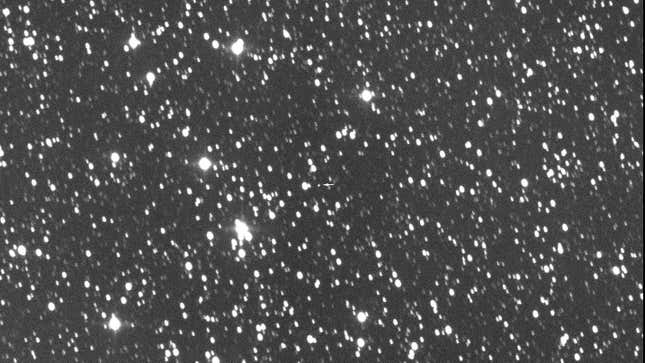
A robotic telescope in Italy has caught a faint glimpse of the Webb Space Telescope at its final location some 1 million miles from Earth.
The new image comes courtesy of the Virtual Telescope Project 2.0, an astronomical program that provides real-time observations of space with remotely controlled telescopes. The 300-second exposure showing Webb at L2 was taken by the 17-inch telescope “Elena,” which operates near Rome, Italy.
The $10 billion Webb observatory was approximately 1 million miles (1.4 million km) from Earth when the image was taken. Launched on December 25, 2021, the next-gen telescope has reached the solar orbit from which it will perform infrared astronomical observations. More specifically, Webb has reached the second Sun-Earth Lagrange point, aka L2. This location offers a clear and unhampered view of the cosmos as well as a highly stable orbit that doesn’t require an excessive amount of fuel to maintain.

NASA issued the final course correction at 2:00 p.m. EST on Monday. The five-minute-long thruster burn caused Webb to move 3.6 miles per hour (1.6 meters per second) faster, “which was all that was needed to send it to its preferred ‘halo’ orbit around the L2 point,” according to a NASA statement.
Moving forward, Webb will need to toot its thrusters for a minute or so once every three weeks to stabilize its orbit, as SpaceNews reports. In what is brilliantly amazing news, Keith Parrish, Webb observatory commissioning manager, told reporters yesterday that the mission will likely last for more than the expected 10 years.
“You’ve heard numbers around 20 years. We think that’s probably a good ballpark,” Parrish said, to which he added: “We don’t think fuel is going to be on our mind as far as a life-limiting thing going forward.”
Webb is now fully deployed, including its sunshield and 18-mirror-array, but there’s still plenty of work to be done. Bill Ochs, Webb project manager, said mission planners “are now on the verge of aligning the mirrors, instrument activation and commissioning, and the start of wondrous and astonishing discoveries.” Webb is expected to enter into the science phase of the mission around June.
More: Debris From Russian Anti-Satellite Test Nearly Slammed Into Chinese Satellite.